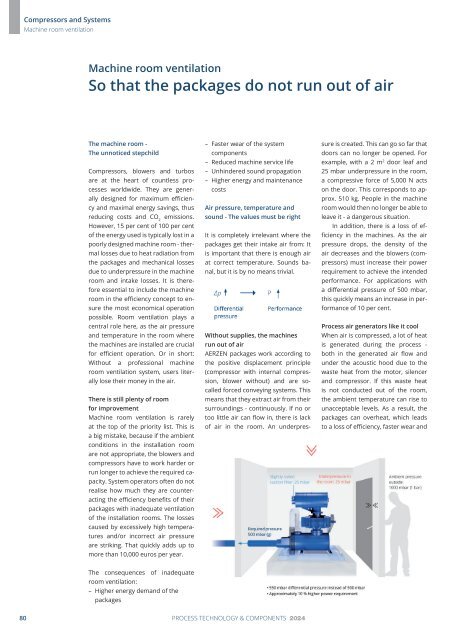PuK - Process Technology & Components 2024
A technical trade magazine with a history of more than 60 years.
A technical trade magazine with a history of more than 60 years.
You also want an ePaper? Increase the reach of your titles
YUMPU automatically turns print PDFs into web optimized ePapers that Google loves.
Compressors and Systems<br />
Machine room ventilation<br />
Machine room ventilation<br />
So that the packages do not run out of air<br />
The machine room -<br />
The unnoticed stepchild<br />
Compressors, blowers and turbos<br />
are at the heart of countless processes<br />
worldwide. They are generally<br />
designed for maximum efficiency<br />
and maximal energy savings, thus<br />
reducing costs and CO 2<br />
emissions.<br />
However, 15 per cent of 100 per cent<br />
of the energy used is typically lost in a<br />
poorly designed machine room - thermal<br />
losses due to heat radiation from<br />
the packages and mechanical losses<br />
due to underpressure in the machine<br />
room and intake losses. It is therefore<br />
essential to include the machine<br />
room in the efficiency concept to ensure<br />
the most economical operation<br />
possible. Room ventilation plays a<br />
central role here, as the air pressure<br />
and temperature in the room where<br />
the machines are installed are crucial<br />
for efficient operation. Or in short:<br />
Without a professional machine<br />
room ventilation system, users literally<br />
lose their money in the air.<br />
There is still plenty of room<br />
for improvement<br />
Machine room ventilation is rarely<br />
at the top of the priority list. This is<br />
a big mistake, because if the ambient<br />
conditions in the installation room<br />
are not appropriate, the blowers and<br />
compressors have to work harder or<br />
run longer to achieve the required capacity.<br />
System operators often do not<br />
realise how much they are counteracting<br />
the efficiency benefits of their<br />
packages with inadequate ventilation<br />
of the installation rooms. The losses<br />
caused by excessively high temperatures<br />
and/or incorrect air pressure<br />
are striking. That quickly adds up to<br />
more than 10,000 euros per year.<br />
– Faster wear of the system<br />
components<br />
– Reduced machine service life<br />
– Unhindered sound propagation<br />
– Higher energy and maintenance<br />
costs<br />
Air pressure, temperature and<br />
sound - The values must be right<br />
It is completely irrelevant where the<br />
packages get their intake air from: It<br />
is important that there is enough air<br />
at correct temperature. Sounds banal,<br />
but it is by no means trivial.<br />
Without supplies, the machines<br />
run out of air<br />
AERZEN packages work according to<br />
the positive displacement principle<br />
(compressor with internal compression,<br />
blower without) and are socalled<br />
forced conveying systems. This<br />
means that they extract air from their<br />
surroundings - continuously. If no or<br />
too little air can flow in, there is lack<br />
of air in the room. An underpres-<br />
sure is created. This can go so far that<br />
doors can no longer be opened. For<br />
example, with a 2 m 2 door leaf and<br />
25 mbar underpressure in the room,<br />
a compressive force of 5,000 N acts<br />
on the door. This corresponds to approx.<br />
510 kg. People in the machine<br />
room would then no longer be able to<br />
leave it - a dangerous situation.<br />
In addition, there is a loss of efficiency<br />
in the machines. As the air<br />
pressure drops, the density of the<br />
air decreases and the blowers (compressors)<br />
must increase their power<br />
requirement to achieve the intended<br />
performance. For applications with<br />
a differential pressure of 500 mbar,<br />
this quickly means an increase in performance<br />
of 10 per cent.<br />
<strong>Process</strong> air generators like it cool<br />
When air is compressed, a lot of heat<br />
is generated during the process -<br />
both in the generated air flow and<br />
under the acoustic hood due to the<br />
waste heat from the motor, silencer<br />
and compressor. If this waste heat<br />
is not conducted out of the room,<br />
the ambient temperature can rise to<br />
unacceptable levels. As a result, the<br />
packages can overheat, which leads<br />
to a loss of efficiency, faster wear and<br />
The consequences of inadequate<br />
room ventilation:<br />
– Higher energy demand of the<br />
packages<br />
80 PROCESS TECHNOLOGY & COMPONENTS <strong>2024</strong>

















